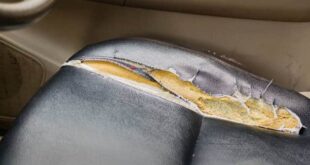Understanding Car Paint Damage
1. Types of Paint Damage
- Scratches: Light surface abrasions that only affect the clear coat.
- Chips: Small areas where the paint has been knocked off, often down to the primer or metal.
- Dents with Paint Damage: Deeper damage where the paint is cracked or flaked.
- Rust: Corrosion that occurs when paint is compromised and exposed to moisture.
2. Assessing the Extent of Damage
- Surface Damage: Scratches and chips can often be repaired with touch-up paint.
- Deeper Damage: Requires more extensive repair, including sanding and possibly repainting.
- Rust: Needs to be treated and sanded before repainting.
Tools and Materials Needed
1. Paint Supplies
- Touch-Up Paint: For small scratches and chips.
- Primer: Prepares the surface for paint and ensures better adhesion.
- Clear Coat: Protects the paint and adds shine.
2. Tools
- Sandpaper: For smoothing the surface before painting.
- Masking Tape: To protect areas not being painted.
- Paint Brushes or Sprayers: For applying paint.
Step-by-Step Car Paint Repair Process
1. Preparation
- Clean the Area: Wash and dry the damaged area thoroughly.
- Sand the Surface: Lightly sand to remove rust and create a smooth surface.
- Mask Off Surrounding Areas: Protect adjacent areas with masking tape.
2. Applying Primer
- Apply Primer: Use a thin coat to ensure even application.
- Allow to Dry: Follow the manufacturer’s drying time instructions.
3. Painting
- Apply Base Coat: Use smooth, even strokes for a consistent color.
- Layering: Apply multiple thin coats if necessary, allowing each layer to dry.
4. Finishing
- Apply Clear Coat: Add a layer of clear coat for protection and shine.
- Polish the Area: Once fully dry, polish to blend the repair with the surrounding paint.
Common Car Paint Repair Mistakes to Avoid
1. Skipping Preparation
- Failing to properly clean and sand the surface can lead to poor adhesion and visible repairs.
2. Overusing Paint
- Applying too much paint in one go can lead to runs and an uneven finish.
3. Inadequate Drying Time
- Rushing the drying process can result in smudges or peeling.
4. Not Matching the Paint Color
- Using the wrong shade can result in noticeable color differences.
Cost of Car Paint Repair
1. DIY vs. Professional Repair
- DIY Costs: Generally lower but requires time and skill.
- Professional Costs: Higher but ensures a high-quality finish.
2. Factors Influencing Cost
- Extent of Damage: More extensive damage costs more to repair.
- Type of Paint: Specialty paints or finishes can increase costs.
Car Paint Repair Tips
1. Always test paint on a small area first to ensure color match. 2. Use high-quality primer and clear coat for a professional finish. 3. Sand the surface thoroughly to remove rust and create a smooth base. 4. Apply paint in thin layers to avoid drips and uneven texture. 5. Allow ample drying time between coats to prevent smudges. 6. Use masking tape and paper to protect areas not being painted. 7. Clean the repair area with a wax and grease remover before painting. 8. Polish the repaired area to blend it seamlessly with the rest of the car. 9. If using a spray can, shake it well and test the spray pattern before application. 10. For large repairs, consider seeking professional help to ensure a flawless finish.
Frequently Asked Questions (FAQs)
1. How long does a car paint repair take?
- It depends on the extent of the damage and the method used. Minor repairs can take a few hours, while extensive work may require several days.
2. Can I repair car paint damage myself?
- Yes, with the right tools and techniques, many paint repairs can be done DIY. However, professional repair ensures a better finish.
3. How do I match the paint color?
- Use the car’s paint code to purchase the exact color or take your vehicle to a professional for color matching.
4. What should I do if the paint doesn’t match?
- You may need to apply multiple layers or consult a professional to blend the repair with the existing paint.
5. How can I prevent rust after a paint repair?
- Ensure the damaged area is properly sanded and primed to prevent moisture from reaching the metal.
6. How much does professional car paint repair cost?
- Costs vary based on damage extent and location but typically range from $300 to $2,000.
7. Can I use regular household paint for car repairs?
- No, automotive paint is specially formulated to adhere to car surfaces and withstand the elements.
8. How long should I wait to wash my car after a paint repair?
- Wait at least two weeks to allow the paint to fully cure before washing.
9. What type of primer should I use?
- Use an automotive primer suited for the type of paint and surface you’re working on.
10. Can I apply clear coat over old paint?
- Yes, but ensure the surface is clean and sanded for the best adhesion.
Conclusion
Car paint repair, while manageable for DIY enthusiasts, often benefits from professional attention, especially for extensive damage. Proper preparation, the right materials, and careful application are key to achieving a high-quality finish. By following the outlined steps and tips, you can restore your vehicle’s appearance and protect its value. Whether you choose to repair your car yourself or seek professional help, understanding the process is crucial for achieving the best results and maintaining your car’s aesthetic appeal.
Related Posts:
- Car Body Repair: Essential Tips for Restoring Your Vehicle
- Car Rust Repair: Comprehensive Guide to Restoring…
- Car Detailing Service: The Ultimate Guide to a…
- Replacement Body Panels: Restoring Your Vehicle's Aesthetics
- Car Cleaning Accessories: Essential Tools for a…
- Car Window Repair: A Guide to Restoring Your…
 oto car insurance used car repair
oto car insurance used car repair
